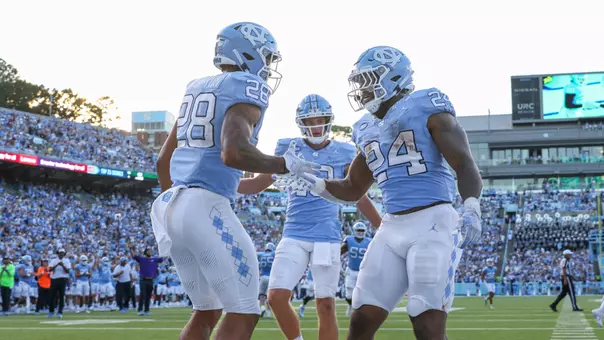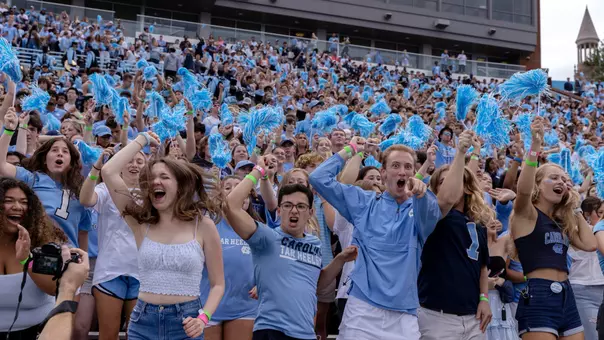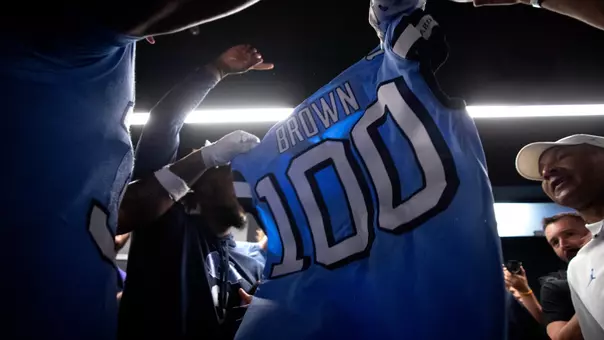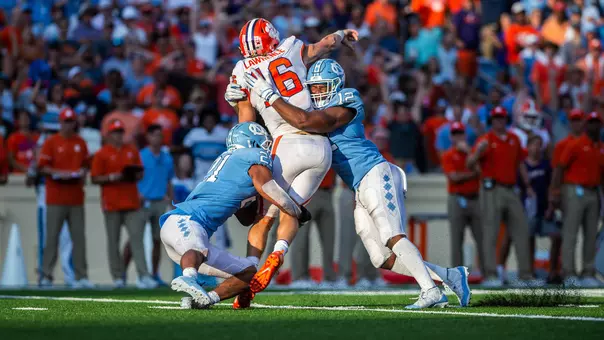University of North Carolina Athletics
EXTRA POINTS SPECIAL: John Bunting: The Carolina Years
April 9, 2001 | Extra Points
April 9, 2001
Part I: Introduction (March 26, 2001)
Part II: The Early Days (April 2, 2001)
The meeting was set for 6 p.m. in a classroom in Woollen Gym: Bill Dooley, ex-assistant coach at Georgia, brand new head coach at Carolina, with his new team. Winter semester, 1967, had just commenced. They closed the classroom doors on the hour, on the dot. Stragglers were not welcome.

senior captains Paul Miller,James Webster, John unting and Lewis Jolley (seated) for the cover of the 1971 Carolina media guide. |
Some players exchanged glances. They could remember three straight losses over the previous three seasons to the Bulldogs--24-8 in 1964, 47-35 in '65 and 28-3 in '66.
"We knew if we got to the third and fourth quarters and it was a close game," Dooley continued, "we'd win the football game. We knew we were mentally and physically tougher than North Carolina."
Privately, Dooley said it was a "country club atmosphere." He'd been told you can't win at Carolina--the school had had three winning seasons in 17 years, and two of those were 6-4--because the town and campus were too liberal, there were too many social distractions, that it all led to a soft football player.
"We intend to do something about that," Dooley said.
The winter workouts began in a few weeks. There was no weight-lifting. It was all running, sprinting and wrestling. The intensity was a shock.
"I still have nightmares about it," says Gayle Bomar, a safety under former coach Jim Hickey who would move to quarterback for Dooley.
"None of us had been through anything quite like it in our lives. A lot of guys decided to hang it up. I think we had 90-some players in the winter, and about 30 dropped out before we made it to spring."

|
"More nightmares," Bomar says. "It was long, it was grueling, it was a tremendous amount of contact every day. I remember one scrimmage on a Saturday in Kenan Stadium. We started about noon, and we could hear the Bell Tower ring every hour. Before it was over, the Bell Tower rang five or six times. It was a long day, a very intense experience.
"Later, I went into the service and went to boot camp. It was a picnic compared to that first spring practice."
One day a manager found a helmet in the bushes, just outside the gate to the practice field. Twenty yards further up the sidewalk was a jersey. Farther up were some abandoned shoulder pads. A little farther were two kidney pads.
Into this atmosphere, this mindset, Dooley welcomed his first full-fledged recruiting class to Chapel Hill in August of 1968. Dooley and his staff had corralled who they could the previous recruiting season, but they had only a month or so to pick up where former coach Jim Hickey and his staff left off. They landed Don McCauley, Flip Ray, John Swofford and Paul Hoolahan, to name a handful. But it was a catch-as-catch-can effort. The following year, Dooley had implemented the Southeastern Conference's highly organized and year-around recruiting methodology into Carolina and the ACC.
John Bunting, for one, wondered what he'd gotten into, stumbling in the dark at 5:30 a.m. from Ehringhaus Dormitory to Kenan Field House.
"I was homesick, I missed my girlfriend, I was overwhelmed," Bunting says. "I remember getting up and walking over when it was still pitch black. They had a little freshman locker room. It was a dark, dingy place. They'd give us a little container of orange juice and an apple and say, `Let's go practice.'
"We'd practice three times a day. I wasn't used to that. I wasn't used to the pace, the tempo, all the good players. All kids coming in face this, even today. All of a sudden, you're not the superstar any more. You're just one good player among many. I was na?ve, thinking I could come in here and be the force I was my last two years in high school. I was overwhelmed by where I'm at, what I'm doing."
Forty-five freshmen were listed as Tar Heels in that season's Carolina game program. Most you've still never heard of. Every one gave some thought to going home those first few days and weeks.
"Every practice, your focus was survival," says James Webster, a safety from Winston-Salem who'd later play linebacker. "The only thing that kept you going was looking around and seeing someone else still on his feet. You thought, `If he can do it, I can do it.'"
"Coach Dooley was in the process of changing attitudes," says John Anderson, a linebacker/guard from Elkin. "It was a boot-camp mentality. We practiced at daybreak until we dropped. We went back at noon until we dropped. Then we went again in the afternoon."
"Gayle Bomar talked me out of going home," says Paul Miller, a quarterback from Ayden. "I was totally homesick."
The coaches were intimidating and gruff. Dooley was only 33, but with a big chest and full-bodied drawl, he looked and sounded like Bear Bryant.
"He scared the heck out of us," says Miller. "To us 18-year-olds, he looked like Methuselah."
His assistants were loud and tough.
"They didn't have any hair," says John Cowell, a tight end from Bayboro. "They looked like Marine drill instructors and literally coached like it. I don't think we saw any of them crack a smile for three years."
Carolina country club?
Bill Dooley was doing as he promised. The program was toughening up. Chapel Hill, at least to a bunch of football players, was becoming the Southern Part of Sing-Sing.
John Bunting came to Chapel Hill wanting to play offense, to follow in the footsteps of hero Jim Taylor, the bruising fullback of the Green Bay Packers.
"Too slow," the coaches said. "Put him at linebacker."
That was a setback to Bunting, but not a major one. Linebacker would do. Then they tried him at center.

N.C. State in 1970 with teammate and current assistant coach James Webster trailing the play. |
It didn't take long for the staff to sense that Bunting was a natural at linebacker. That was where he stayed.
"John was a very intense player, a very dedicated player," says Ron DeMelfi, the Tar Heels' outside linebackers and defensive ends coach. "He worked awfully hard from the moment he got there. We put a lot of demands on the position he played. He was the consummate overachiever, a dedicated student of the game. He was perfect for us."
Fellow linebacker John Anderson says Bunting was the most dedicated player on the team: "Football was a big deal to him. It was to everybody, but it meant more to him."
College football was a ground-oriented, option game in the late-sixties and early-seventies. Three out of every four yards gained by the Tar Heels at the time came on the ground. Duke with QB Leo Hart was the only ACC team of the era that threw the ball with abandon. Bootlegs, play-action, sprint-outs were big. Offenses employed the wishbone, split-back veer, wing-T and Power-I and pressured the corner with regularity.
To combat this offensive mindset, Carolina played a 4-4-3 alignment. Stop the run. Stop the option. Those were the Tar Heels' goals. Bunting was one of the outside linebackers and always flopped to the tight-end side. The two cornerbacks covered the wideouts man-for-man, and the safety had the tight end over the middle and deep. Bunting covered the back out of his side, and the opposite OLB had the other back. Bunting also had quarterback responsibility on the option.
"We were fairly basic," Bunting says. "Coach Dooley did a great job recruiting. We out-personneled most teams. Our point of emphasis was the line of scrimmage. If we came up against a passing team, we struggled sometimes. My junior and senior years, we lost to Tulane. They threw the ball a lot. The game when William & Mary almost beat us my senior year--they were a throwing team."
The freshman class of '68 served as practice fodder for the upperclassmen for one year, a season that saw Dooley's under-manned troops post a 3-7 record. At the time, freshmen were not allowed in varsity games, and red-shirting was not yet a widespread practice.
y the spring of '69, some players had quit, some were hurt, some flunked out. The survivors were in for more of the same intensity the previous two teams had endured. One high school coach from Concord, in Chapel Hill in March for Dooley's high-school coaching clinic, was quite moved by the difficulty of the practice session he watched that weekend. He returned to Concord with dire warnings for Ken Taylor, an end who'd signed a month earlier to attend Carolina.
The coach found Taylor lifting weights in the high school's gym and told him: "Son, that's not going to do you any good. You need to go stand in the corner and have someone throw those weights at you."
unting and his classmates saw little of Chapel Hill that year. None of them had cars. They went to class, study hall, the field house, the training table and the practice field. Occasionally, Bunting remembers, an upperclassman named Bob Hanna would invite him to his room for cards. A couple of times, they snuck out of Ehringhaus late at night, found an entry into the Chapel Hill sewer system and wandered the tunnels with flashlights.
"We'd pop up out of the tunnel and be beside the practice field," Bunting says. "We'd pop up and be by the Bell Tower. We'd pop up and be up on North Campus."
Are you serious?
unting assumes a boys-will-be-boys expression. "It was adventurous. It was dangerous," he says.
unting was married to his high school sweetheart by his sophomore year, and he, Ren? and baby girl Kim moved into a spartan house in Victory Village, a since-demolished neighborhood off Manning Drive built after World War II. They paid $37 a month for two bedrooms, one bath, a pot-bellied stove and walls Bunting describes as being not much stronger than cardboard. He often brought a film projector home after practice and showed film of Saturday's opponent on the wall. Ren? dressed Kim in a Carolina blue dress and a button reading "My Dad's No. 43." It was a simple life, nothing fancy, but a happy one.
"Ask Billy Hite about the dip we served him one time," Bunting says. "Ketchup and mustard, mixed together."
Bunting started his first game as a sophomore and was a fixture over three seasons as the Tar Heels improved to 5-5, 8-4 with a Peach Bowl bid and 9-3 with a Gator Bowl bid. The 1971 team, Bunting's senior year, won Carolina's first-ever outright ACC championship. On that roster were 13 seniors of the original 45 who matriculated in 1968. Six others had been red-shirted and were juniors. Those 19 players enjoy a bond today, 30 years later, that's difficult to define.
"It was like going to Vietnam," Webster says. "Fifty guys get caught in an ambush with crossfire and everyone shooting. You go in with 50 and come out with 20. You don't think those 20 have a bond that'll last a lifetime? You'd better believe it."
John Bunting stood six feet, two inches and weighed 210 pounds as a senior. He sprinted 40 yards in 4.7 seconds. Good numbers, but not outstanding. To be a successful football player at the college level, he needed more. He knew that instinctively. His coaches, teammates and ACC opponents would learn over three years that Bunting would compensate with intelligence, technique and heart.
Bunting had watched very little film through high school, but at Carolina there were plenty of projectors and cans of film throughout Kenan Field House. Ron DeMelfi showed his young linebackers as freshmen and later as sophomores the things to watch for.
Does the tight end vary his stance, his split or his weight balance from one snap to the next, and if so, is there any correlation between the variance and the play executed?
Does the quarterback have nervous tendencies--like licking his fingers or quickening the cadence--before taking the snap on pass plays?
Does the halfback to his side cheat half a gap if he's going out for a pass?
Bunting learned these and hundreds more nuances. He found it a fascinating process. He couldn't watch enough film and encouraged his teammates to watch more than the minimum required by the coaches.

Kim following Carolina's loss at Notre Dame in 1971. The Tar Heels lost, 16-0, but Bunting caught the eye of NFL scouts with his performance that day. |
He grasped not only the Xs-and-Os, but also precise technique.
"John could uncoil and deliver a blow with his forearm very, very quickly," says DeMelfi. "There were not too many tight ends who could block John. But he had terrific leverage and always got under the tight end's pads."
John Cowell and Bunting fought each other day after day in practice."It wasn't fun," Cowell says. "He'd say the same thing." In so doing, Cowell had perhaps the closet look at the intangibles Bunting brought to the field.
"A natural sense for the game can make a huge degree of difference in overcoming lack of pure speed," Cowell says. "Every player has some degree of raw talent, heart and savvy. If you've got all three, you're Lawrence Taylor. If you've got two of them, you can still be a great player. John had heart, and he had savvy."
Bunting impressed his teammates back at Springbrook High in Silver Spring, Md., with his remarkable durability. Now his college peers were marveling as well. He was the epitome of a leader-by-example.
"John was so fierce," says Flip Ray, who played defensive tackle in the class ahead of Bunting. "He would take or deliver the hardest hit you can imagine, then get right back up. His jaw would tighten, his eyes would burn with intensity.
"He wouldn't have to say anything. Just seeing him stare out from behind that facemask was all anyone else needed for motivation."
Bunting became an All-ACC first-teamer in 1971, building a career that included the following highlights:
"I can still see that play today in my mind," says DeMelfi, who left coaching in 1975 to enter a family business in Pennsylvania. "If John does anything wrong on that play, he doesn't get there."
That week was also one in which Dooley, Bunting and the Tar Heels took on a wave of protest which had arisen in the aftermath of the Arnold death. Dooley's program was cleared of any wrong-doing in the tragedy, but former Tar Heel Bill Richardson was joined by some former athletes and activists from the student body and faculty in protesting the rigors of college football. The coaches and players actually left the practice field that week, march en masse to the Student Union and challenged Richardson & Company during a public forum.
"There were all kinds of questions being raised, people from outside campus were coming in to challenge our program," Bunting remembers. "We heard they wanted to dismantle the program. We didn't know exactly what was going on. Bill had something go wrong that day. I carried him off the field. I put him on the truck. We lost a loved brother. We went on, played the season for Bill. But we were strong as a team, strong behind Coach Dooley. It was a difficult time for all of us."
The seniors on this 2001 Tar Heel football team have been through a lot as well. They've witnessed the sudden departure of Mack Brown to Texas, the ascension and star-crossed tenure of Carl Torbush that led to a painful firing just after the pummeling of Duke last November.
They're beginning to figure out what Bunting's all about. If nothing else, when they don a Tar Heel football jersey, they know the boss has walked in their shoes.
"He's one of the family," cornerback Errol Hood says. "He's been here. He knows what it's like to wear that blue."
John Bunting lived to tell about his four years as a Tar Heel. But just barely, as it turned out.
Bill Dooley had a pre-season conditioning exam that called for players to run a mile upon reporting in August. Each position had a designated time to beat. The linebackers' and tight ends' time was five minutes, 45 seconds.
"We wanted to see what kind of shape they were in," says Dooley. "John was always in good shape, but he just wasn't a distance runner."
Neither was John Cowell. Both missed their times as sophomores and juniors, the latter year by three seconds for Cowell and eight for Bunting.
"And we paid for it dearly with extra sprints after practice," Bunting says today.
Cowell remembers eating lunch in the training table after missing his time as a junior and his position coach, Vic Spooner, walking by and virtually spitting at him, "Three seconds--that's the difference between a winner and a loser."
As seniors in 1971, both made their times.
"At least that's what they said," says Bunting today with a wry smile. "I'm not sure about that. All I know is coach Dooley wanted us to make our times."
Bunting and Cowell were presented with a sheet cake afterward from one of the coaches' wives. "Congratulations to the Milers," was written in icing on the top.
Running the mile--the only splotch on the performance record of new Tar Heel head coach John Bunting. Don't look for his players to do any distance running any time soon.
"I'm not sure it has anything to do with playing football," he says. "But that's all right. It didn't hurt me. I guess it just made me a little tougher."
That's what the early-seventies and Tar Heel football were all about.
Lee Pace, editor and publisher for 11 years of Extra Points, a newsletter devoted to the careful study of Tar Heel football, has interviewed dozens of family members, former teammates, players and coaches who have touched and been touched by Bunting for this exclusive series of articles. From his youth in Silver Spring, Md., to his days as a Tar Heel from 1968-71, from his days as a Philadelphia Eagle to his start in the coaching business at Rowan University, you'll relive the influences and special moments that have shaped Bunting's life over the next several installments of "The Bunting Era Dawns For Carolina."
Next Monday: Lee Pace returns with Part IV of "The Bunting Era Dawns For Carolina."
Part I: Introduction (March 26, 2001)
Part II: The Early Days (April 2, 2001)
Thanks to the following businesses and individuals who have helped fund this series on John Bunting:
UNC Dept. of Athletics
The Educational Foundation Inc.
Gayle Bomar, IJL Wachovia
John Anderson, General Shale Brick
Paul Miller, Quixtar
John Cowell, The Home Team





